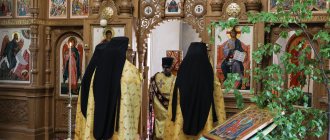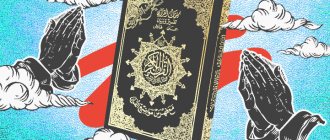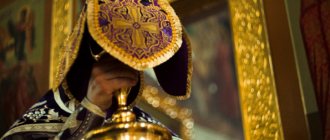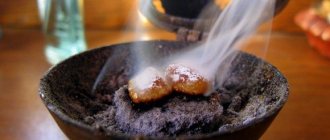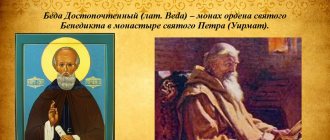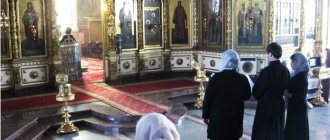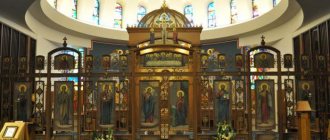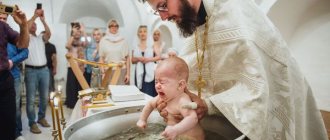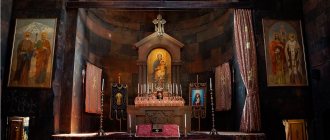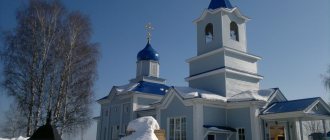The Christian cult dates back two thousand years. During this time, his ritual practice evolved into a system of extremely complex ceremonies. Of course, for the full implementation of the latter, a material base is necessary: clergy vestments, church premises, church utensils and other elements, without which not a single service or sacrament can take place. This article will discuss the issue of utensils that are used in the Russian Orthodox Church.
Liturgical items
Liturgical objects are objects used in the performance of worship.
The Eucharistic Lamb is a quadrangular
A lectern (Greek “book stand”) is a tall, elongated tetrahedral table with a flat board for the convenience of reading liturgical books while standing or venerating icons placed on it.
Antidoron ( Greek - instead of gift) - part of the prosphora from which the Eucharistic Lamb was taken out for the sacrament of communion. Distributed to the faithful at the end of the liturgy.
Antimins - (Greek - instead of and Latin throne) - a quadrangular platform made of silk or linen with sewn-in particles of relics, on which the liturgy is performed.
Artos (Greek - bread) is bread that is blessed with a special prayer on Easter Day. It is kept in the church throughout Bright Week, and on Easter Saturday it is crushed (cut into small pieces) and distributed as a shrine. Artos reminds believers that the Savior has risen and is with us.
Liturgical books are books for performing divine services, containing the rites of services and liturgical (statutory) instructions. They are divided into sacred liturgical and church liturgical.
Crowns - crowns made of non-ferrous metal, placed on the bride and groom during the wedding - the Sacrament of Marriage.
Air is a rectangular plate that is placed on the paten and chalice during the liturgy. When reading the Creed, the priest raises the air and shakes it over the Holy Gifts. This sacred act is performed as a sign of the breath of the Holy Spirit over them.
The monstrance is one of the small sacred vessels, a metal box in which the Holy Gifts are carried for communion with the sick in homes and hospitals.
Tabernacle is a metal It is made in the form of the Chapel of the Holy Sepulcher.
Dikiriy ( gr. - two-candlestick) - a portable candlestick with two candles, used during bishop's service.
Paten (Greek - round dish) is one of the main sacred vessels used in the liturgy. A small-sized dish on a stand on which the Lamb is prepared, consecrated and crushed, that is, part of the main prosphora that is transformed into the Body of Christ in the sacrament of the Eucharist.
Oil is consecrated olive (or other vegetable) oil used in some church rites.
The staff is a richly decorated staff that the bishop carries during worship. The rod is a sign of the highest pastoral authority. The staff is also given to archimandrites and abbots, as heads of monasteries.
The altar is a quadrangular table located in the north-eastern part of the altar (to the left of the throne), dressed in the same clothes as the throne - srachitsa and indium.
The star is one of the sacred items of church utensils. It consists of two cross-shaped arcs connected at the top. After the end of the proskomedia, it is placed on the paten over the Holy Lamb. It symbolizes the wonderful star, behind which the Magi followed to Bethlehem to worship the born Savior.
Censer – 1) a metal vessel on chains intended for censing; 2) smoking incense (Ps. 141:2).
The pulpit (ancient Greek seat; seat) is a chair for the bishop, installed in the temple.
Altar cross - A cross with the image of the Crucified Lord, placed on the throne next to the Gospel.
An aspirate is a liturgical object, which is a bundle of waterproof elastic plant or artificial fibers, with a handle, used by the priest for sprinkling (i.e., sprinkling crosswise) with holy water.
Incense is an fragrant tree resin, sometimes with the addition of oil of fragrant flowers or aromatic plants, used in the temple for incense.
Lampada ( Greek “lamp”) is an oil lamp lit in front of the icons, on the throne and the seven-branched candlestick.
A liar is an elongated spoon with a cross on the handle, used for communion for the laity.
Orlets is a round rug with an image of an eagle, on which the bishop stands during worship.
A chandelier is a large lamp, like a chandelier with many candles (or light bulbs), hanging from the dome in the central part of the temple.
Plat is an accessory for wiping the sacred vessels located on the altar.
The Shroud is a quadrangular plate, usually made of velvet, with a painted or embroidered image of the body of Christ the Savior taken from the Cross. Also a shroud with the image of the deceased Mother of God.
Pokrovets are cross-shaped cloth covers for the paten and chalice, introduced into use in ancient times to protect the Holy Gifts.
The throne is a quadrangular table established in the middle of the altar, consecrated with a special rite and dressed in sacred clothes (srachitsa and indium).
Prosphora (Greek - offering) is a small round loaf of bread, consisting of two connected parts, symbolizing the two natures of Jesus Christ: divine and human. On the top of the prosphora, special seals are used to make impressions of images of the cross, the Mother of God or saints.
Ripida (Greek - fan, small fan) - an accessory of the bishop's service, which is a silver or gilded circle on a long handle, inside the circle is an image of the face of a six-winged seraphim.
Altar utensils
The church utensils of the altar are more diverse, since the deacon, priest and bishop ceremonial includes a huge variety of all sorts of “bells and whistles”. The most famous of them, of course, is the censer. This is a metal bowl suspended on chains. This device is used for censing, that is, fumigating the temple with incense - a traditional resinous Middle Eastern incense.
But the following church utensils are of greatest importance in Orthodoxy: chalice, paten, spear, spoon, star and coverings. Together they are called the Eucharistic set, as they serve to celebrate the most important sacrament of the Christian church - the Eucharist. The chalice is a metal bowl similar to a large goblet. Eucharistic wine is poured into it. A paten is a dish on a stand intended for bread. A spear is a kind of knife with which this bread is ritually cut. The liar, that is, the spoon, serves for the communion of the Eucharistic gifts of the faithful. The paten is covered with an asterisk on top, so that a cover - a small fabric blanket - can be placed on it. The chalice is also covered with the same shroud.
There are many other, less important objects of church worship: vessels for wine, oil, bread, altar crosses, tabernacles, etc. But we will not dwell on these attributes here.
What are liturgical vestments?
The vestments in which clergy perform services have been formed over the course of the two thousand year history of the Church.
In general terms, their set had developed by the 6th century AD, but the change in forms, in fact, continues to this day. In Byzantium, church vestments acquired pomp and splendor, borrowing many details from court ceremonial. For example, the poruchi and the bishop's sakkos originated from the robe of the Roman emperor. Each detail of the vestments has its own name and symbolic meaning. Even their color is strictly determined by tradition (you can read about this at the end of this article). Vestments are the clothes that clergy and clergy wear during services. In addition to them, there are also clothes of holders of church rank: cassock, cassock, skufia. These clothes are supposed to be worn outside the temple (however, according to established practice, this is not always observed). We will talk about them separately. We will also talk separately about such attributes of holy orders as the pectoral cross and panagia.
Priests are those who have undergone the sacrament of ordination: bishops (Patriarch, metropolitan, archbishop, bishop), priests (priest, archpriest, abbot, archimandrite), deacons (deacon, archdeacon, protodeacon). We will explain these terms separately in more detail.
In addition to the clergy, there are clergy - those who help during the service: altar servers (sacristans, readers), singers, bell ringers. Nowadays, only altar servers are required to wear a special robe - the surplice. In some periods of church history, other clergy also wore special clothes.
All clergy wear a cassock during the service. Robes are put on over it. The higher the rank, the more of these vestments and the more complex their symbolism.
Types of liturgical vestments
Each church rank corresponds to a special vestment.
Production of utensils
The presence of a huge number of Orthodox churches in Russia requires mass production of church utensils. There are quite a lot of factories and workshops that offer a choice of their goods, but the official and main enterprise among them is Sofrino, whose church utensils are directly produced by the Moscow Patriarchate. This is a large plant serving all of Russia and some CIS countries. It is located in the Moscow region in the settlement of the same name.
There are internal regulations for the clergy that prohibit or limit the acquisition of necessary religious items anywhere other than Sofrino. At the same time, church utensils are extremely expensive and often lack quality, which clergy often complain about.
Alternative factories produce products of an order of magnitude better quality, both in terms of internal characteristics and visual ones. They are located in various cities and regions. But the main place of concentration of enterprises where church utensils are produced is Moscow.
Vestments of the altar boy (sexton, reader)
The surplice is a long shirt with wide sleeves, with slits from the armpits to the bottom, fastened with buttons. Symbolizes purity and innocence.
The deacon during the service symbolizes an angel. His attire also indicates this.
Surplice
- a long shirt with wide sleeves, with slits from the armpits to the bottom, fastened with buttons.
Symbolizes purity and innocence. Saint Simeon of Thessalonica wrote: “ The surplice
(i.e. the robe
of the deacon
, as well as
the altar boy
)
represents the light clothing of the angels
.”
Orar
- a long wide ribbon worn over the shoulder over the surplice.
Unlike the priest's epitrachelion, it does not fold in half, but falls freely along the back and chest. Symbolizes the wing of an angel
.
The name "orar" comes from the Latin oro
- “to pray” or from the Greek “I watch, guard, observe”, or from the Latin orarium - “towel, lention”.
Entrust
(sleeves) - put on the ends of the sleeves of a cassock or cassock, fixing them. They are trapezoidal strips of dense material with an image of a cross on the outside. Attached to the hands thanks to lacing. They symbolize God's power and grace, thanks to which the clergy perform the Sacraments. The orders also remind us of the bonds by which the Savior was bound during His suffering, and also indicate that integrity in business is required of the clergyman.
Excerpt characterizing Church utensils
On October 6, early in the morning, Pierre left the booth and, returning back, stopped at the door, playing with a long purple dog on short crooked legs that was spinning around him. This little dog lived in their booth, spending the night with Karataev, but sometimes she went somewhere in the city and returned again. It had probably never belonged to anyone, and now it was owned and had no name. The French called her Azor, the soldier storyteller called her Femgalka, Karataev and others called her Gray, sometimes Visly. The fact that she didn’t belong to anyone and that she didn’t have a name or even a breed, or even a specific color, didn’t seem to make things difficult for the purple little dog. Her furry tail stood firmly and roundly up, her crooked legs served her so well that often she, as if neglecting the use of all four legs, gracefully raised one hind leg and very deftly and quickly ran on three legs. Everything was a matter of pleasure for her. Now, squealing with joy, she lay on her back, now she was basking in the sun with a thoughtful and significant look, now she was frolicking, playing with a sliver of wood or a straw. Pierre's attire now consisted of a dirty, torn shirt, the only remnant of his previous dress, soldier's trousers, tied with strings at the ankles for warmth on Karataev's advice, a caftan and a peasant's hat. Pierre changed a lot physically during this time. He no longer seemed fat, although he still had the same appearance of size and strength that was hereditary to their breed. A beard and mustache have grown over the lower part of the face; the overgrown, tangled hair on his head, filled with lice, now curled up like a cap. The expression in the eyes was firm, calm and animatedly ready, such as Pierre’s gaze had never had before. His former licentiousness, which was also expressed in his gaze, was now replaced by an energetic, ready for activity and rebuff - selectedness. His feet were bare. Pierre looked either down across the field, through which carts and horsemen were driving around this morning, then into the distance across the river, then at the little dog pretending that it seriously wanted to bite him, then at his bare feet, which he gladly rearranged into different positions, wiggling his dirty, thick, thumbs. And every time he looked at his bare feet, a smile of animation and self-satisfaction crossed his face. The sight of these bare feet reminded him of everything that he had experienced and understood during this time, and this memory was pleasant to him. The weather had been calm and clear for several days, with light frosts in the mornings - the so-called Indian summer. It was warm in the air, in the sun, and this warmth, with the invigorating freshness of the morning frost still felt in the air, was especially pleasant. Everything, both distant and nearby objects, had that magical crystal shine that only happens at this time of autumn. In the distance one could see the Sparrow Hills, with a village, a church and a large white house. And bare trees, and sand, and stones, and roofs of houses, and the green spire of a church, and the corners of a distant white house - all this was unnaturally clearly cut out in the thinnest lines in the transparent air. Nearby could be seen the familiar ruins of a half-burnt manor house, occupied by the French, with dark green lilac bushes growing along the fence. And even this ruined and dirty house, repulsive with its ugliness in cloudy weather, now, in its bright, motionless brilliance, seemed somehow soothingly beautiful. A French corporal, unbuttoned at home, wearing a cap, with a short pipe in his teeth, came out from around the corner of the booth and, with a friendly wink, approached Pierre. – Quel soleil, hein, monsieur Kiril? (that’s what all the French called Pierre). On dirait le printemps. [What is the sun like, eh, Mr. Kiril? Just like spring.] - And the corporal leaned against the door and offered Pierre a pipe, despite the fact that he always offered it and Pierre always refused. “Si l'on marchait par un temps comme celui la... [It would be nice to go on a hike in such weather...],” he began. Pierre asked him what had been heard about the march, and the corporal said that almost all the troops were marching out and that now there should be an order about the prisoners. In the booth in which Pierre was, one of the soldiers, Sokolov, was dying of illness, and Pierre told the corporal that he needed to dispose of this soldier. The corporal said that Pierre can be calm, that there is a mobile and permanent hospital for this, and that there will be orders for the sick, and that in general everything that can happen has been foreseen by the authorities. – Et puis, monsieur Kiril, vous n'avez qu'a dire un mot au capitaine, vous savez. Oh, c'est un... qui n'oublie jamais rien. Dites au capitaine quand il fera sa tournee, il fera tout pour vous... [And then, Mr. Kiril, you should say a word to the captain, you know... He’s like that... he doesn’t forget anything. Tell the captain when he makes his rounds; he will do everything for you...] The captain, about whom the corporal spoke, often and for a long time talked with Pierre and showed him all kinds of indulgence. – Vois tu, St. Thomas, qu'il me disait l'autre jour: Kiril c'est un homme qui a de l'instruction, qui parle francais; c'est un seigneur russe, qui a eu des malheurs, mais c'est un homme. Et il s'y entend le... S'il demande quelque chose, qu'il me dise, il n'y a pas de refus. Quand on a fait ses etudes, voyez vous, on aime l'instruction et les gens comme il faut. C'est pour vous, que je dis cela, Monsieur Kiril. Dans l'affaire de l'autre jour si ce n'etait grace a vous, ca aurait fini mal. [Now, I swear by Saint Thomas, he once told me: Cyril is an educated man, he speaks French; This is a Russian gentleman with whom a misfortune happened, but he is a man. He knows a lot... If he needs something, there is no refusal. When you have learned something, you love education and well-mannered people. I'm talking about you, Mr. Kiril. The other day, if it weren’t for you, things would have ended badly.] And, after chatting for a while longer, the corporal left. (The thing that happened the other day, which the corporal mentioned, was a fight between prisoners and the French, in which Pierre managed to pacify his comrades.) Several prisoners listened to Pierre’s conversation with the corporal and immediately began to ask what he said. While Pierre was telling his comrades what the corporal had said about the performance, a thin, yellow and ragged French soldier approached the door of the booth. With a quick and timid movement, raising his fingers to his forehead as a sign of bow, he turned to Pierre and asked him if the soldier Platoche, to whom he had given the shirt to be sewn, was in this booth. About a week ago, the French received shoe goods and linen and distributed boots and shirts to the captured soldiers to sew. - Ready, ready, falcon! - Karataev said, coming out with a neatly folded shirt. Karataev, for the sake of warmth and for the convenience of work, was wearing only trousers and a tattered shirt as black as the earth. His hair was tied with a washcloth, as craftsmen do, and his round face seemed even rounder and prettier. - A persuader is a brother to the cause. “As I said by Friday, I did so,” said Plato, smiling and unfolding the shirt he had sewn. The Frenchman looked around uneasily and, as if overcoming doubt, quickly took off his uniform and put on his shirt. Under his uniform the Frenchman did not have a shirt, but on his bare, yellow, thin body he wore a long, greasy, silk vest with flowers. The Frenchman, apparently, was afraid that the prisoners looking at him would laugh, and hastily stuck his head into his shirt. None of the prisoners said a word. “Look, just right,” Plato said, pulling off his shirt. The Frenchman, sticking his head and hands through, without raising his eyes, looked at his shirt and examined the seam. - Well, falcon, this is not a trash, and there is no real instrument; “But it’s said: without gear you can’t even kill a lice,” said Plato, smiling roundly and, apparently, rejoicing at his work. – C'est bien, c'est bien, merci, mais vous devez avoir de la toile de reste? [Okay, okay, thank you, but where is the canvas, what’s left?] - said the Frenchman. “It will be even better the way you put it on your body,” said Karataev, continuing to rejoice at his work. - That will be good and pleasant. “Merci, merci, mon vieux, le reste?..” repeated the Frenchman, smiling, and, taking out a banknote, gave it to Karataev, “mais le reste... [Thank you, thank you, dear, but where is the rest?.. Give me the rest. ] Pierre saw that Plato did not want to understand what the Frenchman was saying, and, without interfering, looked at them. Karataev thanked him for the money and continued to admire his work. The Frenchman insisted on the remainder and asked Pierre to translate what he was saying. - What does he need the leftovers for? - said Karataev. “They would have given us some important little extras.” Well, God bless him. - And Karataev, with a suddenly changed, sad face, took out a bundle of scraps from his bosom and, without looking at it, handed it to the Frenchman. - Ehma! - Karataev said and went back. The Frenchman looked at the canvas, thought about it, looked questioningly at Pierre, and as if Pierre’s gaze told him something. “Platoche, dites donc, Platoche,” suddenly blushing, the Frenchman shouted in a squeaky voice. – Gardez pour vous, [Platosh, and Platosh. Take it for yourself.] - he said, handing over the scraps, turned and left. “Here you go,” Karataev said, shaking his head. - They say that they are not Christ, but they also have a soul. The old men used to say: a sweaty hand is a bit too hard, a dry hand is stubborn. He himself is naked, but he gave it away. – Karataev, smiling thoughtfully and looking at the scraps, was silent for some time. “And the important ones, my friend, will be blown out,” he said and returned to the booth. Four weeks have passed since Pierre was captured. Despite the fact that the French offered to transfer him from a soldier's booth to an officer's booth, he remained in the booth he entered from the first day. In devastated and burned Moscow, Pierre experienced almost the extreme limits of hardship that a person can endure; but, thanks to his strong constitution and health, which he had not been aware of until now, and especially due to the fact that these hardships approached so imperceptibly that it was impossible to say when they began, he endured his situation not only easily, but also joyfully . And it was at this very time that he received that peace and self-satisfaction for which he had vainly strived before. For a long time in his life he was looking from different sides for this peace, agreement with himself, for what struck him so much in the soldiers at the Battle of Borodino - he looked for this in philanthropy, in Freemasonry, in the dispersion of social life, in wine, in heroic deeds self-sacrifice, in romantic love for Natasha; he sought this through thought, and all these searches and attempts all deceived him. And he, without thinking about it, received this peace and this agreement with himself only through the horror of death, through deprivation and through what he understood in Karataev. Those terrible minutes that he experienced during the execution seemed to have washed away forever from his imagination and memories the disturbing thoughts and feelings that had previously seemed important to him. The thought of neither Russia, nor the war, nor politics, nor Napoleon occurred to him. It was obvious to him that all this did not concern him, that he was not called and therefore could not judge all this. “No time for Russia, no union,” he repeated Karataev’s words, and these words strangely reassured him. His intention to kill Napoleon and his calculations about the cabalistic number and the beast of the Apocalypse now seemed incomprehensible and even ridiculous to him. His anger against his wife and anxiety about not disgracing his name now seemed to him not only insignificant, but funny. What did he care about the fact that this woman was leading the life she liked somewhere out there? Who, especially him, cared whether they found out or didn’t find out that the name of their prisoner was Count Bezukhov? Now he often recalled his conversation with Prince Andrei and completely agreed with him, only understanding Prince Andrei’s thought somewhat differently. Prince Andrei thought and said that happiness can only be negative, but he said this with a tinge of bitterness and irony. As if, by saying this, he was expressing another thought - that all the aspirations for positive happiness invested in us are invested only in order to torment us, not satisfying us. But Pierre, without any second thought, recognized the justice of this. The absence of suffering, the satisfaction of needs and, as a result, the freedom to choose occupations, that is, a way of life, now seemed to Pierre to be the undoubted and highest happiness of a person. Here, now only for the first time, Pierre fully appreciated the pleasure of eating when he was hungry, drinking when he was thirsty, sleeping when he was thirsty, warmth when he was cold, talking with a person when he wanted to talk and listen to a human voice. Satisfaction of needs - good food, cleanliness, freedom - now that he was deprived of all this seemed to Pierre to be perfect happiness, and the choice of occupation, that is, life, now that this choice was so limited, seemed to him such an easy matter that he forgot the fact that an excess of the comforts of life destroys all the happiness of satisfying needs, and the greater freedom to choose occupations, the freedom that education, wealth, position in the world gave him in his life, that this freedom makes the choice of occupations insolublely difficult and destroys the very need and opportunity to study. All Pierre's dreams now aimed at the time when he would be free. Meanwhile, subsequently and throughout his life, Pierre thought and spoke with delight about this month of captivity, about those irrevocable, strong and joyful sensations and, most importantly, about that complete peace of mind, about perfect inner freedom, which he experienced only at this time . When on the first day, getting up early in the morning, he came out of the booth at dawn and first saw the dark domes and crosses of the Novodevichy Convent, saw the frosty dew on the dusty grass, saw the hills of the Sparrow Hills and the wooded bank meandering over the river and hiding in the purple distance, when felt the touch of fresh air and heard the sounds of jackdaws flying from Moscow across the field, and when then light suddenly splashed from the east and the edge of the sun solemnly floated out from behind the clouds, and domes, and crosses, and dew, and the distance, and the river, everything began to sparkle in a joyful light , - Pierre felt a new, unexperienced feeling of joy and strength of life.
Priest's vestments
The priest performing the service independently symbolizes Christ.
If he serves with the bishop, then he symbolizes one of the apostles. There are small and full priestly vestments. All services except the Liturgy are performed in small vestments. It includes a phelonion, bristles, epitrachelion
.
In full, this set includes a cassock, a belt
and, if available,
a legguard and a club
.
The cassock is a long shirt made of thin (usually silk) material, which is worn under the phelonion (over the cassock) when celebrating the Liturgy. Has narrow sleeves.
Felonne
- a long sleeveless cape, with a cutout for the head, covering the body of the priest. Worn over a cassock or cassock, belt, brace, epitrachelion.
The history of the formation of the appearance of the felonia
Nowadays ,
the veil is made long at the back, and at the front this vestment has a rounded neckline, so that it reaches only the waist.
In ancient times
The felonies were very long - to the toes, both behind and in front. In fact, it was a paly - an antique cloak cut “sun”. He even hid the priest’s hands, which symbolically indicated that the priest performed the Sacraments not with his own, but with God’s power, as well as his renunciation of worldly temptations and money-grubbing.
In medieval Russia
the phelonion had a small shoulder and the same length in front and back - approximately to the knees. There were 5 buttons sewn on the front side of the phelonion. At certain moments of the service, the front part of the chasuble was raised and secured with their help.
Reliquaries
- A reliquary
is a small box or casket for storing religious relics. - Reliquary
is a general name for containers for storing relic particles. - Reliquary
is an ark containing the relics of saints, usually made in the shape of a coffin. - Encolpion
- a small reliquary of rectangular, round or cross shape
- Kovchegs (Museums of Moscow Kremlin) 05.JPG
Ark
- Moshchevik.jpg
Reliquary
- Raka (Annunciation Cathedral in Moscow) 01 by shakko.jpg
Cancer
Russian and Greek felonion
In different national traditions, the phelonion looks different. The Russian phelonion has a rigid, standing trapezoidal collar, while the Greek one rests loosely on the shoulders. Presumably, the standing mantle of the Russian phelonion appeared thanks to cold winters: it protects well from drafts.
Greek phelonion has a number of practical advantages: it weighs less, is easier to sew, wash, and transport.
The solid shoulder of the Russian felonie requires delicate handling so as not to lose its shape, so it is removed before washing. The front part of the classic Greek phelonion is slightly longer than that of the Russian one. Since this is unusual for some Russian priests, a Russified version appeared - with a shortened front part.
Symbolic meaning of felony
Simeon, Archbishop of Thessalonica, speaks about the spiritual meaning of the phelonion: “ The phelonion is sewn without sleeves to represent the sackcloth in which the Savior was dressed during the reproach.
This priestly garment covers the entire body, from head to feet, in the image of God's Providence, which from the beginning supports and protects us. During the sacred rite, the phelonion is raised with both hands, and these hands, like wings, signify angelic dignity , and the actions performed by them, the effective force with which the priest performs the Sacrament.
The sacred phelonion means the highest and bestowed power and enlightenment of the Holy Spirit
.
This clothing signifies both the lordship of the first ranks of the Mountains, and the power of God, containing everything, providential, omnipotent, beneficial, by which the Word descended even to us and through the incarnation, crucifixion and rebellion united everything above with what is below .”
The four horizontal stripes on the phelonion symbolize the four Gospels
. At the top of the phelonion on the back there is a cross, at the bottom there is an eight-pointed star, which is sometimes called a custodian. This indicates the unity of the Old and New Testaments.
Helpful advice. Features of tailoring felonies
In vestments, the clergyman should be able to easily move, bow, raise his hands in prayer, and raise his hand for a blessing.
It should not move or warp. It's important to pay attention to the details. For example, it is good when the front part of the phelonion ends 20 centimeters below the pectoral cross
. During the service, the priest raises his hands and the front of the phelonion is wrapped. If there is still enough fabric below the cross, it ends up in the resulting “pocket”, rises and falls along with the edge of the chasuble. Thus, we do not show parishioners an upside-down cross.
It is important that the lining of the mantle of the phelonion be made of high-quality non-woven material, durable enough, but not too heavy so that the priest does not feel as if he is wearing chains.
Epitrachil _
- a long ribbon of dense fabric, folded in half so that both ends descend onto the priest’s chest.
In front it is connected by buttons, of which there should be 7 - according to the number of Sacraments of the Church
(this is not always observed).
According to tradition, the epitrachelion is decorated with crosses. Symbolically, the epitrachelion points to a lamb, which the good shepherd takes on his shoulders and carries, saving it from wolves - that is, to counseling
, which the priest is obliged to do.
Also, being essentially a modified version of the orarion, the epitrachelion tells us that the priest has greater grace than that of the deacon. The deacon assists in the performance of the Sacraments and services, and the priest performs them. In current practice, the epitrachelion and armbands make up a set - they are made of the same fabric, in a common style. Epitrachelion and guards
are mandatory attributes necessary for a priest to perform the Sacraments.
Handrails (sleeves)
– put on the ends of the sleeves of a cassock or cassock, fixing them.
They are trapezoidal strips of dense material with an image of a cross on the outside. Attached to the hands thanks to lacing. They symbolize God's power and grace
, thanks to which the clergy perform the Sacraments. The orders also remind us of the bonds by which the Savior was bound during His suffering, and also indicate that integrity in business is required of the clergyman.
Belt
- put on over the cassock.
It is quite wide, tied with ribbons on the back, and has an image of a cross in front. Symbolically speaks of vigor, readiness for service
, as well as strength and spiritual power. Reminiscent of the towel with which the Savior girded himself when washing the feet of the apostles.
Gaiter
– a rectangular cloth plate attached to the belt with ribbons. It has a cross in the center. It is one of the hierarchical awards of the Church (see article about them). A priest who has not yet received the right to carry a club wears a legguard on the right side, and one who has received it wears it on the left.
Mace
- a diamond-shaped board, hung from the belt at the upper corner. It is worn on the right side. Given to priests as a reward.
Church items of the Orthodox Church
The Orthodox Church has a history of more than one and a half thousand years, and during this long historical period it has developed a special attitude towards church objects. All property is divided into sacred and church property. The sacred includes things intended for direct worship, the second includes everything else. In turn, the former are divided into sacred by definition and sanctified. Sacred objects include temples, churches, all altar items and vessels. Consecrated places include houses of prayer, cemeteries, ladles, lamps, candlesticks and some other things.
The entire list of church supplies is very long and each item has its own symbolic purpose and history. According to the location of church objects inside the temple, they can be divided into:
Altar items; Items from the rest of the temple; Reliquary.
The altar or altar part includes a throne, an altar, vessels and textiles.
The altar is located in the central part of the altar. He is covered with vestments, and with two garments. The first lower one is made of linen fabric and symbolizes the shroud of Jesus Christ. The top brocade layer symbolizes the Lord's robe. The altar contains a piece of holy relics. In addition, on the altar there are other church objects necessary for divine services, including the altar Gospel and so on.
Altar. In the northern part of the altar, on the left side of the altar, there is a table decorated with fabrics, on which gifts for the sacraments are prepared. It (the table) is called an altar. Here are the items necessary for the sacrament of communion.
Vessels. Church items include more 10
types of vessels, each of which has its own purpose and the use of one vessel for several different events is excluded.
Textile. The purpose of textiles in the church ranges from decoration and protection of the altar, to the carpet under the feet of the bishop. Also, some materials are placed under especially revered icons. The shroud and robe of the Lord are of particular importance.
The rest of the temple items include all kinds of seats, benches, candlesticks, a font and other attributes of the Orthodox Church. A separate type of church objects is the reliquary, which houses religious relics and relics of saints, which are of great importance for the Christian church.
Colors of liturgical vestments in the Russian tradition
The color of church vestments in the Russian tradition depends on which day of the liturgical year is celebrated.
This tradition began to take shape in the West in the 12th century and, having come to Rus', spread here in the 17th–18th centuries. Its latest changes occurred relatively recently. Finally, the clergy enter the religious procession - still in white vestments. Believers walk around the temple. It sounds restrained and solemn: “ Thy Resurrection, O Christ the Savior, the angels sing in heaven, and grant us on earth to glorify You with a pure heart.”
" Candle lights flicker in the night air. Worshipers approach the closed doors of the temple - now they symbolize the Holy Sepulcher.
How and why the color of Easter vestments changed from snow-white to red - there are various guesses. But in the Church everything is providential. And the fact that Russian believers began to celebrate Easter, like the days of the holy martyrs, in red robes precisely in that century when the Russian Church shone with a host of New Martyrs, cannot but be remarkable.
The Easter period is ending. On Ascension they serve in white robes - in honor of the Lord's holiday. Trinity is coming. On this day, churches greet pilgrims with the life-affirming green color. The green vestments of the clergy echo the color of the young foliage of the birch trees that decorated the temple for the holiday. In some parishes the floors are covered with fresh grass. At this time, everything in nature blooms. The leaves have blossomed on the trees, the flowers in the gardens and meadows are fragrant. Green is the color of life, joyful and peaceful. Such life is given to the believing soul by the Holy Spirit, and in the Church the color green indicates the Third Person of the Holy Trinity. That is why they serve in green on Trinity, when the fiery tongues of the Spirit descended on the apostles. In the same vestments, services are performed on the days of the saints - people who have devoted their entire lives to acquiring the Holy Spirit and have succeeded in this.
Source
Antique store "Antique Shop": valuation, purchase and sale of antiques
Church utensils for connoisseurs of religious history and culture
Ancient religious objects have not only unconditional historical value, but also great religious significance. In past centuries, all church utensils were made in accordance with the canons and rules, since they were mainly intended for rituals and services. A modern collector, purchasing, for example, a church fold , understands the true value of the object, each door of which is made by a carver in the form of a separate icon, and sometimes a small iconostasis. At the same time, despite the apparent simplicity of the design of such a product, no one has yet succeeded in repeating the work of the masters of the 19th century.
What is included in this category of goods and how is their price determined?
Church utensils include both items of temple decoration and various attributes intended for performing rituals. In the “Antiquity Shop” store you can buy an antique lamp , glass amulet and much more. Some works of art have no analogues and are personally signed by the author. The cost of such items depends on the following factors:
- the condition of the product, when determining which, first of all, its integrity is taken into account, as well as the clarity of all available drawings and parts;
- materials that were used in the manufacturing process of the item;
- the age of the work, its authorship, and in some cases the origin of the real owner of the equipment;
- weight and cost of precious and semi-precious stones used in the production of the product;
- artistic value of an antique object.
Folder - an important page in religious history
Particularly popular among Orthodox Christians has always been the tricuspid fold , made so that the middle part can be easily closed with the help of two side flaps. Historians suggest that the prototype of such a product was the royal gates. In Rus', miniature triptychs were most often worn on a garter, and also taken with them on long trips, packed in luggage. It should be noted that the process of manufacturing bronze antique folding frames was quite labor-intensive. That is why the early products were not of good quality. However, manufacturers of such items continued to master technology, constantly honing their skills. And in the 19th century, the production of such religious paraphernalia reached its perfection. In the “Antiquity Shop” store you can purchase a large four-leaf folding unit , which can become a real decoration for the modern home of any believer, as well as buy folding units consisting of two or three leaves, and other antique items. Our customers are often interested in church utensils made by modern craftsmen, the perfect condition of which we guarantee.
